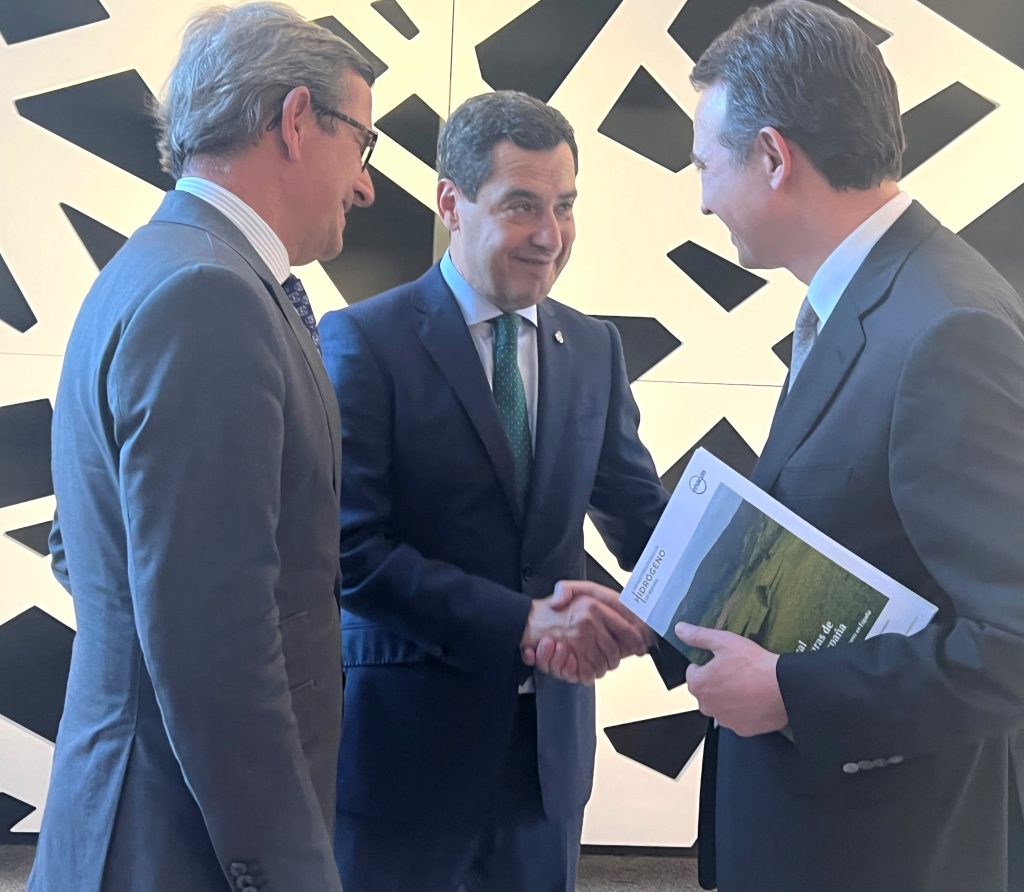Juanma Moreno Bonillo, President of the Regional Government of Extremadura, and Enagás CEO Arturo Gonzalo met today to analyse the progress of the Public Participation Conceptual Plan (PPCP) for the Spanish hydrogen backbone network in Andalusia. At the meeting, which was also attended by the Regional Minister for Industry, Energy and Mines, Jorge Paradela, they reviewed the details of this project, which will contribute to the sustainable economic development of Andalusia.

Since the start of the PCPP in Andalusia on 1 July, participatory meetings have been held in eight localities: Belalcázar and El Viso, in the province of Cordoba; and Almonte, Bonares, Hinojos, Lucena del Puerto, Palos de la Frontera and Rociana del Condado, in the province of Huelva. In addition, information points have been set up in 10 municipalities: Almonte, Bonares, Hinojos, Lucena del Puerto, Palos de la Frontera and Rociana del Condado, in Huelva; Belalcázar and El Viso, in Cordoba; and Benacazón and Villamanrique de la Condesa, in Seville.
In total, the PCPP will pass through 23 municipalities in Andalusia – 8 in Huelva, 12 in Seville and 3 in Cordoba – until 26 September.
Palos de la Frontera and the province of Seville: green hydrogen nodes.
Andalusia will have a network of approximately 165 km of hydrogen pipelines along the Vía de la Plata Axis and the Puertollano Connection. More specifically, this network will have two sections in Andalusia: Huelva-Merida, covering a distance of about 147 km and Almendralejo-Puertollano, a distance of approximately 18 km.
The initial layout of the future hydrogen network will convert Palos de la Frontera – where the Enagás regasification plant in Huelva is located – and the province of Seville into aggregation nodes for future green hydrogen production and consumption projects.
The results of the Call For Interest submitted in 2024 – of the first axes of the Spanish Hydrogen Backbone Network that form part of the European Project of Common Interest (PCI) list, identify Andalusia as one of the main centres of consumption and production of renewable hydrogen in Spain.
Public Participation
Andalusia is the region that has been chosen for the largest public participation plan of its kind in Spain, which will pass through a total of 13 autonomous communities and over 500 municipalities. Enagás launched the plan on 25 April at the National Hydrogen Centre in Puertollano, in Castile-La Mancha, the first autonomous community in which Enagás held participatory workshops open to all interested parties. Subsequently, the Participation Plan continued in Extremadura, Andalusia and Cantabria.
The Spanish hydrogen backbone network’s PPCP will harness the inputs of the autonomous communities and the councils of the towns and cities through which it passes, the 50-plus government authorities, 380 organisations and associations and all the citizens interested in taking part. The deployment of the Plan in Spain is expected to take 18 months, and, once it has been completed, a final report on the results of the process will be drawn up.
The aim of the Plan is to share information on the future hydrogen network with all the stakeholders, resolve queries, explain the need for the project, foster the active participation of the communities in the process, mitigate any impacts on the ground, and guarantee the most appropriate social and environmental actions from an early stage.

All the available information on the PPCP can be viewed at https://www.infraestructurasdehidrogeno.es/